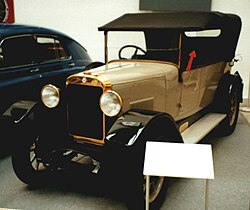Pilot 6/30 hp
| pilot | |
|---|---|
|
Pilot 6/30 HP as Phaeton
|
|
| 6/30 hp | |
| Production period: | 1924-1928 |
| Class : | Middle class |
| Body versions : | Limousine , landaulet , roadster , touring car , panel van , pick-up |
| Engines: |
Otto engine : 1.5 liters (22 kW) |
| Length: | 3900 mm |
| Width: | 1560 mm |
| Height: | 1830 mm |
| Wheelbase : | 2820 mm |
| Empty weight : | 970 kg |
| Previous model | Pilot 6/22 hp |

The Pilot 6/30 PS was the second and last car model from the manufacturer Pilot-Wagen AG . The production took place between 1924 and 1928.
description
The car appeared as the successor to the Pilot 6/22 hp . The concept was similar to the Fiat 501 which was a huge success.
In contrast to its predecessor, the four-cylinder engine was constructed more simply and, as was common at the time, only had two valves per cylinder . A 66 mm bore and 110 mm stroke resulted in a displacement of 1510 cm³ . This means that the engine has been rated with 6 taxable horsepower . It made 30 hp .
The engine power was transmitted to the rear axle via a cardan shaft . The unsynchronized transmission had four gears.
The chassis had a wheelbase of 282 cm and, according to the manufacturer, a track width of 125 cm . In the case of a vehicle that has survived, the track width has been measured at 146 cm (front) and 156 cm (rear). It is unclear whether the vehicle was modified during the 70 years it was in service.
The chassis weighed 680 kg and the complete vehicle 970 kg as a touring car .
As a touring car, the vehicles were 390 cm long, 156 cm wide and, with the top, 183 cm high. Other well-known bodies were two- and four-door sedans , landaulets , roadsters , panel vans and a combined passenger and delivery van, similar to a pick-up . Most of the bodies were manufactured by the Sächsische Waggonfabrik Werdau AG . In addition, a structure from Seegers & Sohn from Leipzig and one from glasses from Dresden have survived.
The maximum speed stated was 95 km / h.
A facelift in the fourth quarter of 1926 saw the introduction of four-wheel brakes.
A total of either 200 or 600 vehicles were built. The Reichspost and Reichswehr are said to have ordered seventy delivery vans in 1926/27 .
Three vehicles still exist today. One with a glass body is in the Dresden Transport Museum .
motor race
This model was also used in several car races. There was a race track near Berlin . A Mr. Lehmann from Zwickau and Kurt Noack from Possendorf have been handed down as drivers .
literature
- Michael Dünnebier: Pilot car from Bannewitz. A contribution to Saxon automotive history.
